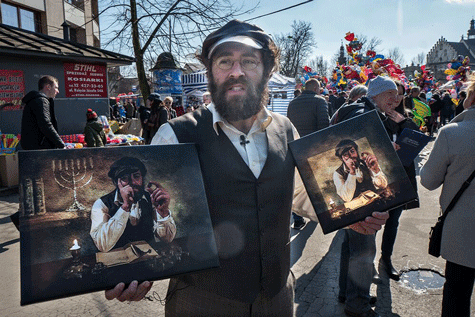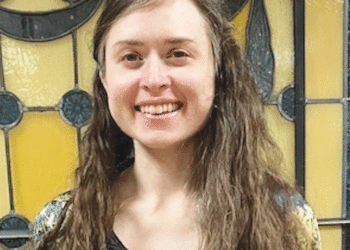By CNAAN LIPHSHIZ
(JTA) — Visit a few main marketplaces or trinket shops in Warsaw or Krakow, and you’re almost guaranteed to find a figurine or picture of a haredi Orthodox Jew counting money.
Offensive to some and just bizarre to others, the sale of stereotypical images of Jews as good luck charms started in Poland in the 1960s. It closely followed the last large wave of Jewish emigration from the country, where 3.3 million Jews lived before the Holocaust. Only 20,000 Jews live there now.

Critics believe it is an expression of centuries of anti-Semitic bias in a country whose society and government are famously struggling with the tragic history of Poland’s once-great Jewish community. The “Lucky Jew” images are “deeply rooted in negative stereotypes,” Rafal Pankowski, a founder of the Warsaw-based Never Again anti-racism organization, said in a December statement. (His condemnations helped force the Polish parliament’s souvenir shop to drop its Lucky Jew figurines.)
Others, like Jonny Daniels, founder of the From the Depths group that promotes dialogue between Jews and Poles, dismiss it as an “insensitive but ultimately harmless expression of nostalgia,” similar to how some view cigar store Indians in the United States.
But some are simply fascinated by the phenomenon and its significance beyond its obvious perpetuation of the notion that Jews and money are inseparable.
Take Michael Rubinfeld, a Canadian-Jewish theater actor and producer who moved to Poland in 2014 and married a Krakow Jewish woman in 2015. In recent months, he has begun selling in marketplaces pictures of himself counting coins, which he markets as part of an act, he told Vice in an interview published Monday.
“These Lucky Jews are just so politically incorrect and absurd that it instigates an equally politically incorrect response of delight in me,” Rubenfeld, 39, told Vice.
His hope, he added, “is to undo the anti-Semitic image from within, through humor, in effect to push Poles into a critical awareness of the anti-Semitism running beneath the Lucky Jew iconography, while at the same time forcing Jews to question their own anti-Polish stereotypes.”
To do that Rubenfeld, armed with a formidable chestnut beard, dresses up like a character from Fiddler on the Roof, sets up a stall whose base is emblazoned with the words “Lucky Jew” and peddles his Lucky Jew self-portraits. They are also available on the website created by Rubenfeld and his company, FestivALT.
“The whole thing doubles as a meta-commentary performance on a problematic custom and an actual straight-up business,” Graham Isador wrote in Vice.
The business side of things is going all right, Rubenfeld told JTA. Since March, when Rubenfeld began peddling the artifacts with his wife, Magda Rubenfeld Koralewska, they have sold some 40 portraits of him counting money.
Priced between $5 and $13, the merchandise is clearly meant for consumption by locals, but tourists, too.
Rubenfeld said his critics don’t grasp “the deep tradition of Jewish satire and auto-irony.” Besides, he told Vice, “when groups voluntarily adopt derogatory and stereotypical terms applied to them and then rebrand them from within, the result is to shift their meaning and weaken the stereotype.”
But if his goal is to diminish the popularity of Poland’s Lucky Jew figurines, Rubenfeld’s act has had very limited impact, according to Daniels.
“You’d be amazed how many educated people from the elite — lawyers, journalists, civil servants — own these figurines and images,” Daniels said.
They are so popular that they make common wedding and housewarming gifts. In some households, the images are turned on their heads on Friday nights, so the money being counted may fall down on the family that owns it.
Still, Daniels believes, the figurines are “part of a longing for Jews, not hatred of them.”
Such longing prompts Polish villagers to attend mock Jewish weddings, stage Jewish music festivals and create a national graffiti campaign called “I miss you, Jew.” Similar to a vogue for Judaism in Spain and Portugal, where Jews were driven out during the Inquisition, “the figurines are an attempt at reconnecting with Jews, not mocking them,” Daniels said.
Like Rubenfeld, Daniels has used humor to get Poles to reassess the Lucky Jew figurines. In September, he posed for a cover picture in the weekly magazine of the prestigious Rzeczpospolita daily while wearing a kippah, counting coins and smiling mischievously at the camera. In the article, Daniels invited the paper’s hundreds of thousands of readers to frame the portrait and put in on the wall for good luck.
“By becoming the lucky charm Jew,” he told JTA, “my intention was to make readers see how absurd it looks from the outside, and maybe get them thinking.”



















